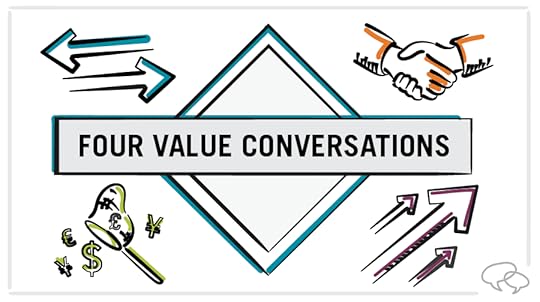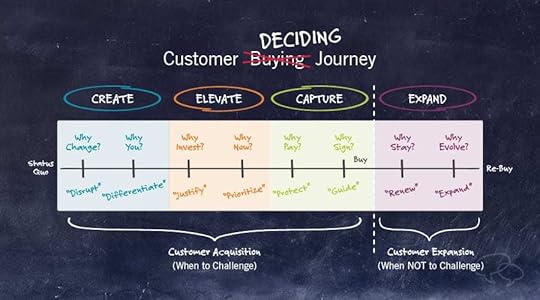The Deciding Journey: Four Value Conversations You Need to Master
The post The Deciding Journey: Four Value Conversations You Need to Master by Tim Riesterer appeared first on Corporate Visions.
[image error]

When you think about the customer journey, you might recall the stages in a typical buying journey model, like Awareness, Consideration, and Decision. But in practice, the B2B customer buying journey doesn’t follow such a broad or predictable sales process.
When you label a prospect as being in the “Consideration” stage, for example, what does that really tell you? Nothing about their motivations. Nothing about their needs. And nothing about how you should approach that sales conversation or how you can provide them value.
So, what happens? If you’re like
most sales organizations, you approach the conversation as a “trusted advisor,”
asking your customers lots of questions, using those questions to diagnose the
customer’s needs, and then presenting a solution that fits the criteria.
This approach does you and your
customer a disservice—and it’s the opposite of what it takes to master sales
conversations today. To be of value to your buyers, it’s no longer sufficient
to say, “Tell me what you want; I’ll get it for you.” Buyers now want
salespeople who will tell them what they should want. They want you to
do the heavy lifting of sifting through all the information that’s out there,
and to deliver insight into what they’re missing that will improve their
performance.
To rise to the demands of what great selling requires now, and in the future, it’s not enough to simply follow your documented sales process, checking the boxes along the way. You need to understand and master a new, diverse set of conversation skills and sales techniques that go beyond the traditional customer journey.
You need to understand and respond to the decisions your buyers are weighing in key situational moments across their Customer Deciding Journey.
The Deciding Journey: A Customer Journey Map Backed by Science
[image error]

In the Customer Deciding Journey, your buyers are asking a series of key questions they need to answer to meet specific business goals. The unique pressures of each of these buying moments call for specific stories and situational skills—tailored to meet the demands of the decision at hand.
Create Value™ – Answer Why Change and
Why You by telling a compelling enough story to defeat the status quo
and differentiate your solution from the competition to create more qualified
pipeline. Elevate Value™ – Answer Why Invest and
Why Now by putting together a meaningful business case that helps
executive decision-makers justify releasing budget based on your proposal.Capture Value™ – Answer Why Pay
and Why Sign to expand the size of your deals, avoid unnecessary
discounting, protect your pricing, and maximize your profits.Expand Value™ – Answer Why Stay, Why
Pay More, Why Evolve, and Why Forgive to defend your incumbent
advantage with existing customers and keep and grow their business.
Create Value™
Sales is more about change management than it is about selling. That’s because 60 percent of qualified opportunities end in “no decision.” As the outsider, you’re fighting inertia—or Status Quo Bias. To vanquish this force, you need to disrupt its causes, drive the need for change, and create a buying vision that favors you over your competition. That requires articulating compelling answers for two pivotal questions your prospects are asking: Why Change (why should I do something different?) and Why You (why should I do it with you?).
Elevate Value™
What about when you need to justify the value of your solution or service to busy executive decision makers? Why should they learn more about your solution (Why Pay), and why should they buy into your story and business case—and purchase now (Why Now)? In these conversations, your goal is to demonstrate the urgency for change by highlighting the risks affecting their business, introducing Unconsidered Needs, and providing a solution that will have a positive and tangible impact on their business.
Capture Value™
As deals advance, it becomes
harder to handle pricing pressures and avoid unnecessary discounting.
Salespeople need the training to deal with that pressure and close deals
profitably. In complex selling scenarios, they also need to learn techniques
for guiding conversations through multi-party decision processes and avoiding
any “last mile” challenges to reaching agreement. At this stage, you must avoid
“value leaks” by using Pivotal Agreements—value-based exchanges that you can
use to advance your deals while protecting your value.
Expand Value™
The skills highlighted above
address the sales inflection points when you need to defeat the status quo and
acquire new customers. But what about when you are the status
quo? That involves a drastically different buyer psychology and a dedicated
message development and skills training approach—research proves it. When you
need to retain customers (Why Stay), get them to pay more for your
solution (Why Pay More), expand with them (Why Evolve), or recover
from a service failure (Why Forgive), you need a tailored strategy that
meets to the demands of these moments.
A Better Approach to Selling Across the Customer Journey
One-size-fits-all approaches to your messaging and skills training won’t hold up across the range of decisions you need to influence in each of these critical deciding moments. Today, great selling requires breaking free from the antiquated idea of a customer journey, and getting your customer acquisition and expansion strategies on the right side of the research.
Get our new sales e-book, Winning the Four Value Conversations, to learn the research-backed messaging techniques and situational sales skills you need to master every stage of the Customer Deciding Journey.
Thank you for reading this post from Corporate Visions - Differentiate Your Marketing Messages and Sales Conversations.
Timothy Riesterer's Blog
- Timothy Riesterer's profile
- 3 followers



